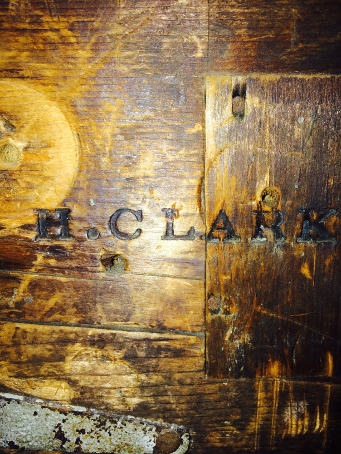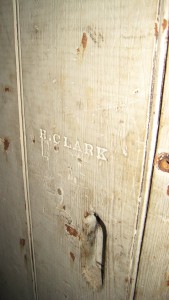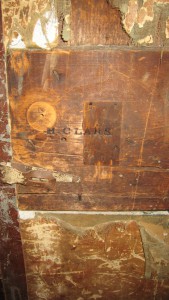
April 6, 2016 Finding Henry Clark’s Mark at the Fowler Clark Epstein Farm
Each time we visit the Fowler Clark Epstein Farm, we discover something that we never noticed before. Sometimes we find photos, magazines or  other remnants from previous occupants. And because the property was last owned by Jorge Epstein, an architectural salvage dealer who brought home some of his architectural finds from other buildings and inserted them into the Fowler Clark property, it’s sometimes difficult to know whether existing building elements are original to the site or something Jorge installed from a different property.
other remnants from previous occupants. And because the property was last owned by Jorge Epstein, an architectural salvage dealer who brought home some of his architectural finds from other buildings and inserted them into the Fowler Clark property, it’s sometimes difficult to know whether existing building elements are original to the site or something Jorge installed from a different property.
We’ve been giving some thought recently to barn doors – wondering what style of door was in the barn originally and what will be appropriate for the barn’s futur e use as the home of the Urban Farming Institute. On a recent visit we examined the design of the existing interior barn doors in hopes of figuring out if they were original to the 1860 structure and might serve as inspiration for future doors (or even be salvagable). The barn is boarded up and has no lighting, so poking around requires a flashlight; this time we noticed something on an interior door that we’d never seen before – one of the doors was stamped “H Clark” on both sides. The family of Henry Clark purchased the property in 1837 and built the barn around 1860, so clearly this is an old, and likely original door to this barn. It appears to have been reconfigured from a sliding door (it has a pull slot) to a double hinged door. We were curious about why it would be stamped with the Clark name. Maybe it was manufactured for the barn and stamped to identify Henry Clark as the customer who ordered it? We decided to ask our partners in the preservation carpentry program at North Bennet Street School if they had any ideas about this. They did not, but shared our curiosity and forwarded our question to others who might know. Here’s a response from Robert Adam, former preservation carpentry instructor at NBSS and current advisor:
e use as the home of the Urban Farming Institute. On a recent visit we examined the design of the existing interior barn doors in hopes of figuring out if they were original to the 1860 structure and might serve as inspiration for future doors (or even be salvagable). The barn is boarded up and has no lighting, so poking around requires a flashlight; this time we noticed something on an interior door that we’d never seen before – one of the doors was stamped “H Clark” on both sides. The family of Henry Clark purchased the property in 1837 and built the barn around 1860, so clearly this is an old, and likely original door to this barn. It appears to have been reconfigured from a sliding door (it has a pull slot) to a double hinged door. We were curious about why it would be stamped with the Clark name. Maybe it was manufactured for the barn and stamped to identify Henry Clark as the customer who ordered it? We decided to ask our partners in the preservation carpentry program at North Bennet Street School if they had any ideas about this. They did not, but shared our curiosity and forwarded our question to others who might know. Here’s a response from Robert Adam, former preservation carpentry instructor at NBSS and current advisor:
“These look like late 19th century sliding doors that have been converted into swinging doors with Tee hinges. The stamp is a hot stamp that probably was used to mark produce boxes for market to be returned to the farm. Stamps and brass stencils were common ways of marking containers for shipping. I am surprised that it only is a name and not a product or address included, but that would make it a pretty big stamp, and probably too big to easily heat. I think that the stamping on the door and other places was just a place to “try out” the hot branding iron stamp and probably has no other significance.”
So this is an interesting bit of information; it doesn’t appear that the wood on the door was once part of a produce box. Maybe someone decided to use a box stamp for ornamentation on the door? We’ll likely never know, but it was fun to discover something that clearly belonged to the Clark family.



